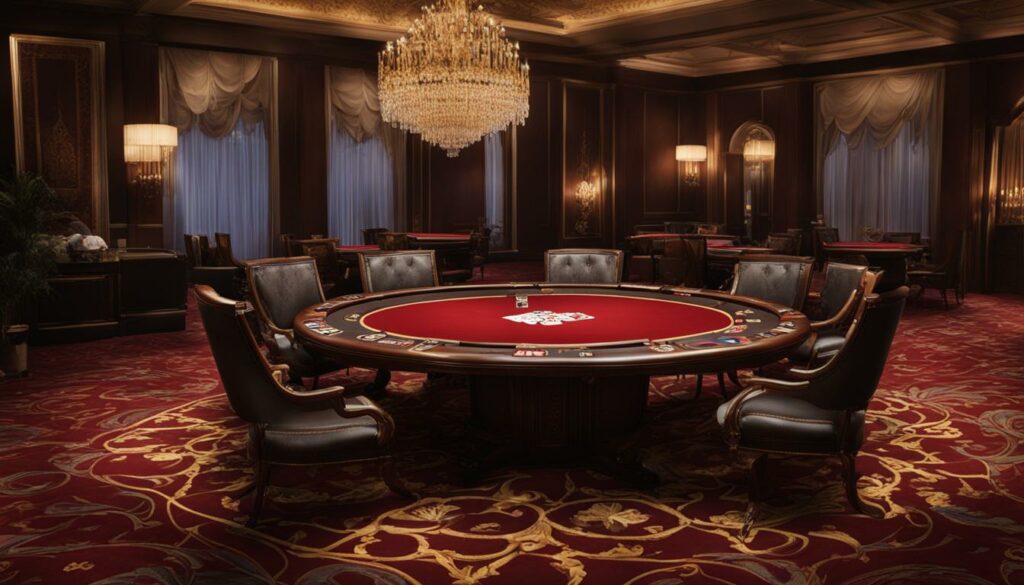Poker is an exhilarating card game that brings joy and entertainment to its players. The gaming experience can be enhanced by choosing the right poker table size to accommodate the desired number of players. Whether you’re playing at home or in a professional setting, figuring out how many players can play poker at once is crucial for a great game.
This article will explore the different factors that contribute to an optimal poker table size. Determining the ideal poker table capacity, understanding standard poker table sizes, and examining the effects that different table sizes can have on gameplay will be discussed. We will also evaluate the advantages and disadvantages of various table sizes, as well as the importance of customizing the table size for different poker variants.
Determining the Ideal Poker Table Capacity
When it comes to determining the ideal poker table capacity, there are several factors to consider. The poker table capacity refers to the number of players that can comfortably participate in a game at once. The determining ideal capacity may vary depending on the available space, comfort and gameplay dynamics.
Available Space: The available space is one of the most critical factors when determining the ideal poker table capacity. The table dimensions directly impact the number of players that can fit comfortably around the table. While a standard poker table measures 8 feet long and 4 feet wide, a larger space may be required for tables that can accommodate more players.
Comfort: Ensuring the comfort of all players is another crucial factor to consider. An overcrowded table can lead to cramped playing conditions that negatively impact the overall gaming experience. Including sufficient elbow room and seating space between each player can provide optimal comfort and enjoyment during the game.
Gameplay Dynamics: Finally, the gameplay dynamics themselves play a crucial role in determining the ideal poker table capacity. A game may not have optimal gameplay dynamics if there are too few or too many players. A good range of players at the table can heighten the game’s excitement level without making it too complicated or convoluted.
Standard Poker Table Sizes
Standard table sizes are commonly used in both professional and home poker games as they provide a consistent and comfortable playing experience for players. It is essential to choose the right table size that can accommodate the desired number of players and provide enough space for each person to move around comfortably.
The maximum number of players that a standard poker table can accommodate ranges from 2 to 10, depending on the table size. The recommended number of players per poker table is typically 8 or fewer, as this number provides enough space for players to comfortably move around and handle their chips and cards without crowding.
| Table Size | Shape | Maximum Number of Players | Recommended Number of Players |
|---|---|---|---|
| 48 inches | Round | 2-4 | 4 |
| 54 inches | Round | 5-6 | 6 |
| 60 inches | Round | 7-8 | 8 |
| 72 inches | Oval | 9-10 | 8 |
Above: Standard poker table sizes, maximum number of players, and recommended number of players per poker table.
It is important to note that while larger tables can accommodate more players, they can also slow down the overall game speed and make it difficult for players to interact with each other effectively. Smaller tables, on the other hand, can lead to a faster game pace, but players may feel cramped and have trouble moving around.
Choosing the right table size can also depend on the type of poker variant being played. For example, Texas Hold’em is commonly played with 8 or fewer players while Omaha can accommodate 10 or more players at a larger table.
Effects of Different Table Sizes on Gameplay
The number of players at a poker table affects several aspects that can impact the gameplay dynamics of a poker game. These effects can be positive or negative, depending on the player limitation, and they can include:
- Hand frequency: With more players, there are typically fewer hands dealt per hour. Conversely, with fewer players, hands are dealt faster, resulting in a rapid game pace and more significant opportunities to play more hands.
- Playing style: The playing style can change depending on the number of players. With a full table, players are typically conservative with their bets and play tight. In contrast, when there are fewer players, the gameplay tends to be more aggressive, and players are more likely to take more risks.
- Game flow: The game flow can be disrupted by the number of players. More players cause more pauses in action and longer wait times between hands or rounds. Fewer players lead to a faster pace and smoother flow.
Therefore, it is crucial to consider the poker game dynamic when selecting the correct poker table size. While a full poker table can accommodate more participants, it could result in slower gameplay, disrupting the game’s tempo and making players impatient. On the other hand, a smaller table size provides a faster game pace, but it may limit the probability of interesting strategic play.
In summary, selecting the ideal poker table size relying on the number of players that can participate in the match can significantly impact the gaming experience. Understanding the effects of different table sizes can help players make more confident decisions when determining the optimal poker table size, leading to more enjoyable and engaging poker gameplay.

Advantages and Disadvantages of Various Table Sizes
Choosing the right table size is crucial in creating an enjoyable and successful poker game. Both small and large table sizes have their respective advantages and disadvantages that influence the overall gaming experience.
Playing with a smaller number of players results in faster gameplay and fewer distractions, making it an ideal option for more serious games. It also allows for better player interaction and the chance to hone one’s strategic skills since each individual is more likely to be involved in the game.
On the other hand, larger table sizes offer a more sociable gaming experience and a chance to meet different personalities. It also allows for more opportunities to bluff and create new strategies, as well as helping players conserve their playing chips for longer periods. However, playing with a larger group of players requires more space, which can limit the playing location and reduce player comfort level.

In summary, the table size should be determined based on the specific game variant being played, participant counts, and available space or location. A balance between player comfort, interaction, and strategic opportunities should be achieved for an optimal and enjoyable poker match.
Customizing Table Size for Different Poker Variants
Table size is a crucial factor in poker games and can significantly impact the overall gameplay experience. Different variants of poker may require a different number of players for optimal play. Hence, customizing the table size to accommodate the correct number of players is essential.
For instance, traditional Texas Hold’em, the most popular variant worldwide, is typically played with 2-10 participants. However, for heads-up Hold’em, you only need two players.
Another example is Omaha, played with four cards instead of two in Hold’em, often requiring fewer players for optimal enjoyment. For 6-card Omaha, which is rarer, a minimum of three players is needed for a good game.
It’s also important to consider more specialized poker games like Razz, which is only played with up to eight players. In contrast, other poker games’ participant counts can be even higher, like Seven Card Stud, which can comfortably accommodate eight to ten players.
By customizing the table size for various poker variants, you can enhance the gameplay experience and create an ideal situation that follows each variant’s specific game dynamics.
Popular Poker Variants with Preferred Table Sizes
| Poker Variant | Preferred Table Size |
|---|---|
| Texas Hold’em | 2-10 players |
| Heads-Up Hold’em | 2 players |
| Omaha | 2-8 players |
| 6-Card Omaha | 3-6 players |
| Razz | Up to 8 players |
| Seven Card Stud | 8-10 players |
By customizing the table size for different poker variants, you can cater to the specific requirements of each game, creating an optimal gameplay experience for all participants.
Conclusion
Choosing the appropriate poker table size in relation to the desired number of players is crucial for a successful poker match. A well-designed and appropriate table size can enhance the overall gaming experience, player interaction, and strategic opportunities.
It’s essential to determine the ideal poker table capacity by considering different factors such as available space, comfort, and gameplay dynamics. Standard poker table sizes are widely used in both home games and professional settings. It’s important to note that different table sizes can significantly impact the gameplay dynamics of a poker game.
While smaller tables can increase the speed of play, larger tables offer more player interaction and strategic opportunities. Additionally, customizing table size based on the specific poker variant being played is critical for optimal gameplay.
Overall, the right table size can accommodate the desired number of players, create a comfortable environment, and make for an unforgettable poker playing experience. So, always make sure to choose the correct table size to enjoy a poker match to the fullest.
FAQ
How many players can play poker at once?
The maximum number of players in a poker game can vary depending on the table size. Standard poker tables can accommodate anywhere from 6 to 10 players, with 9 players being the most common. However, larger tables can be used for special events or tournaments, allowing for even more players.
What is the maximum number of players in a poker game?
The maximum number of players in a poker game is typically determined by the table capacity. As mentioned earlier, standard poker tables can accommodate up to 10 players. However, if you are playing in a larger tournament or event, the number of players can exceed this limit.
How many players can a poker table hold?
A standard poker table can hold up to 10 players comfortably. The table’s design and size ensure that each player has enough space to play and maneuver their chips. However, it’s essential to consider the available space and comfort when determining how many players to accommodate on a poker table.
What is the recommended number of players per poker table?
The recommended number of players per poker table is often 9. This number allows for a good balance of action and player interaction while still maintaining a reasonable pace of play. However, smaller tables with 6 or 7 players can provide a more intimate setting and faster gameplay.
Are there any limitations on the number of players in a poker game?
While there is a recommended number of players per poker table, there aren’t any strict limitations on the number of players in a game. It ultimately depends on the table capacity and the preferences of the players involved. However, overcrowding the table can lead to a cramped and uncomfortable playing experience.
How does the number of players affect the gameplay dynamics in poker?
The number of players can significantly impact the gameplay dynamics in poker. With more players, the hand frequency tends to increase, and the overall game flow may slow down. On the other hand, playing with fewer players can result in a faster pace of play and more aggressive betting due to the increased hand strength.






